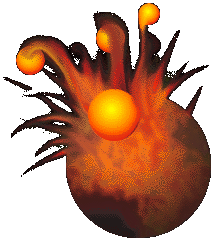|
|
|
Slide 27 of 49 The earth has a huge moon orbiting around it, which scientists now know 1) did not bulge off due to the earth's high rotational speed and 2) could not have been captured by the earth's gravity, due to the moon's large mass and the Earth's proximity to the Sun. For further explanations, see "The scientific legacy of Apollo" (1). The best explanation (other than outright miracle) for the moon's existence is that a Mars-sized planet crashed into the earth around 4.25 billion years ago (the age of the Moon). As you can imagine, the probability of two planets colliding in the same solar system is extremely remote. Any "normal" collision would not have resulted in the formation of the moon, since the ejecta would not have been thrown far enough from the earth to form the moon. The small planet, before it collided with the earth, must have had an unusually elliptical orbit (unlike the orbit of any other planet in the Solar System), which resulted in a virtual head-on collision. The collision of the small planet with the earth would have resulted the ejection of 5 billion cubic miles of the earth's crust and mantle into orbit around the earth. This ring of material, the theory states, would have coalesced to form the moon. In addition, the moon is moving away from the earth (currently at 2 inches per year), as it has been since its creation. If we calculate backwards we discover that the moon must have formed just outside the Roche limit, the point at which an object would be torn apart by the earth's gravity (7,300 miles above the earth's surface). A collision which would have ejected material less than the Roche limit would have formed only rings around the earth. Computer models show that a collision of a small planet with the earth must have been very accurate in order for any moon to have been formed at all (2). Although large collisions were improbable, smaller collisions were extremely common, since the early solar system was littered with debris from its formation. Despite these collisions, life arose at least 3.5 billion years ago (3) and continued to thrive from that point forward. How severe were those collisions? Here is a summary from a recently published article in Science (4):
|
Last updated March 31, 2008
 God
Proclaims His Love:
God
Proclaims His Love: